Deseja instalar o WordPress em seu computador Windows localmente?
Trabalhar com o WordPress em seu computador permite testar novos recursos do WordPress, aprender a desenvolver com o WordPress e criar sites antes de migrá-los para o servidor ativo.
Neste artigo, mostraremos como instalar corretamente o WordPress em um computador com Windows usando dois métodos diferentes. Isso funcionará no Windows 8, Windows 10 e em outras versões do Windows também.
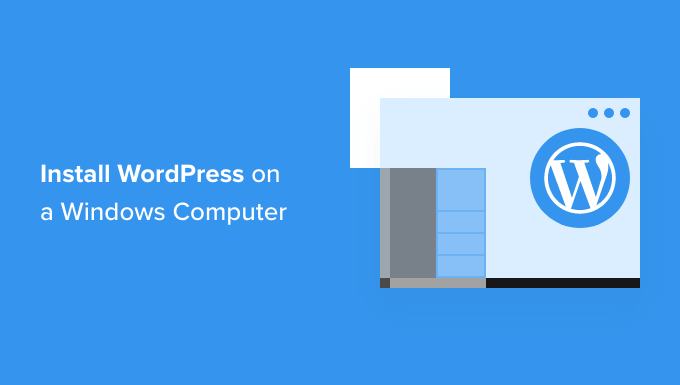
Por que você deve instalar o WordPress no Windows?
A instalação do WordPress localmente em seu computador oferece um ambiente de teste que não afeta seu site ou blog ativo. Uma instalação do WordPress em seu computador também é chamada de servidor local ou localhost.
Normalmente, os desenvolvedores do WordPress usam a instalação local do WordPress para desenvolver seus plug-ins e temas do WordPress.
Os usuários iniciantes também podem instalar o WordPress em seus computadores para aprender sobre o WordPress, testar novos temas e plug-ins do WordPress e fazer experiências sem afetar um site ativo.
Observação: Se você instalar o WordPress localmente no Windows, a única pessoa que poderá ver esse site será você.
Se você quiser criar um site disponível para o público, precisará ter um nome de domínio e uma hospedagem na Web. Recomendamos que você siga este guia sobre como iniciar um blog no WordPress.
Dito isso, vamos dar uma olhada em como instalar corretamente o WordPress em um computador com Windows. Mostraremos duas maneiras fáceis, portanto, você pode clicar no link abaixo para avançar para qualquer seção de seu interesse:
- Método 1: Instalar o WordPress no Windows usando o WP local
- Método 2: Instalar o WordPress no Windows usando o WampServer
Instalar o WordPress no Windows usando o WP local
O Local WP, anteriormente conhecido como Local by Flywheel, é um software da Web local que permite hospedar um site em seu computador, em vez de em um servidor de teste ou ao vivo.
Primeiro, você precisa fazer o download e instalar o software Local WP em seu computador Windows. Basta acessar o site do Local WP e clicar no botão “Download for Free”.
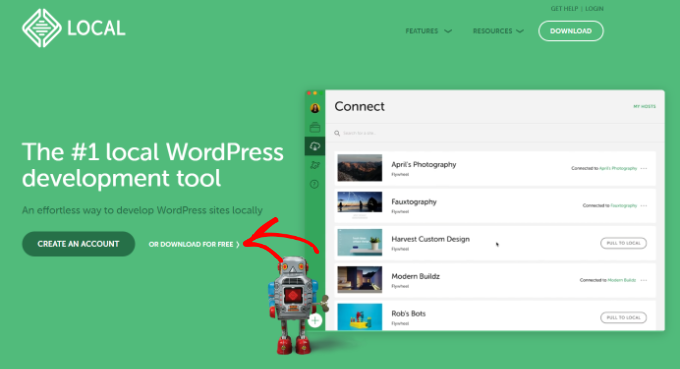
Depois disso, será exibida uma janela pop-up na qual você precisará selecionar sua plataforma.
Vá em frente e escolha “Windows” no menu suspenso.
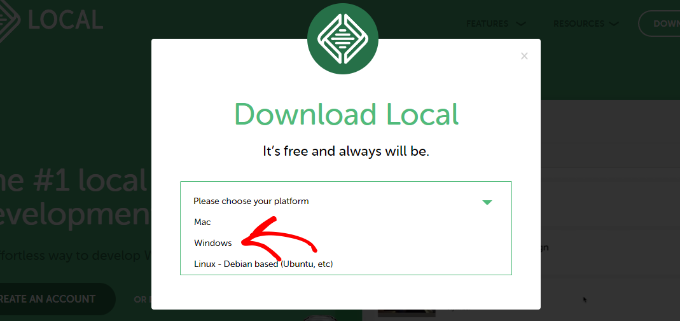
Em seguida, insira seus dados, como nome e sobrenome, endereço de e-mail profissional e número de telefone para fazer o download do software.
Depois de inserir os detalhes, basta clicar no botão “Get it Now”.
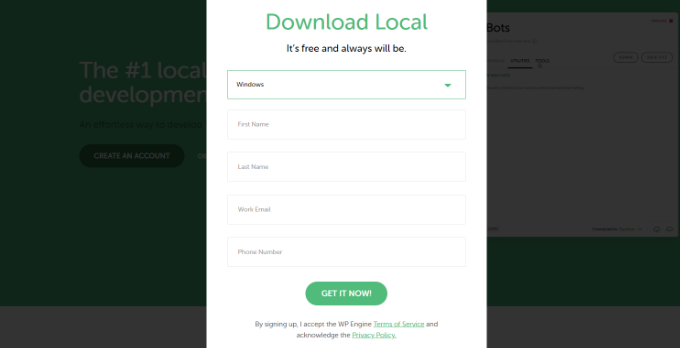
Depois disso, você pode fazer o download do software em seu computador. Após o download, inicie o assistente de configuração.
Agora você precisará selecionar se deseja instalar o software para todos os usuários ou somente para você. Depois de selecionar uma opção, clique no botão “Next” (Avançar).
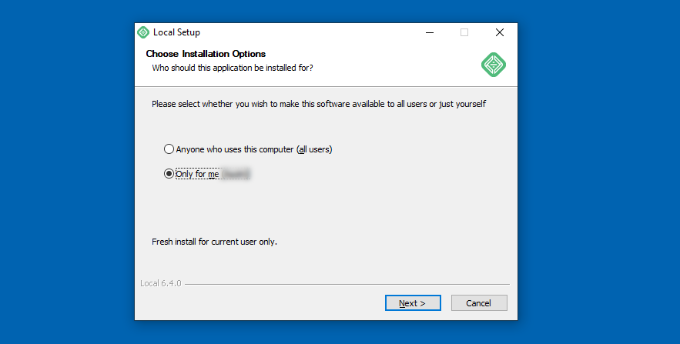
Na próxima etapa, você pode selecionar a “Pasta de destino” onde o software será instalado.
Basta clicar no botão “Procurar” para definir o caminho e, em seguida, clicar no botão “Instalar”.
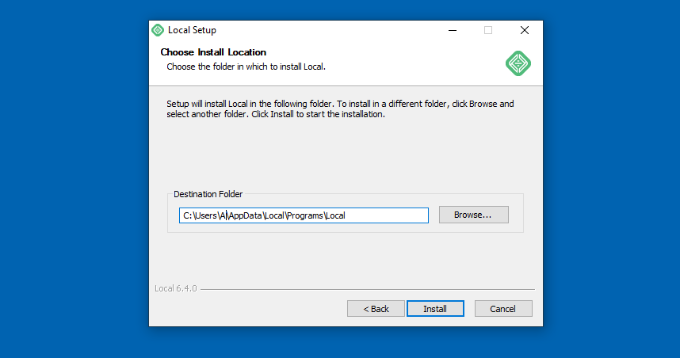
O software Local WP será instalado em seu computador Windows.
Depois de concluído, você pode marcar a caixa de seleção “Run Local” (Executar local) e clicar no botão “Finish” (Concluir) no assistente de configuração.
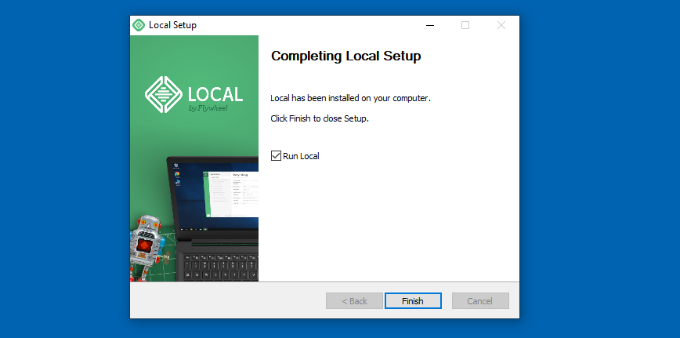
O software será iniciado em seu dispositivo Windows.
A próxima etapa é adicionar um novo site local. Para fazer isso, basta clicar no botão de adição (+) na parte inferior.
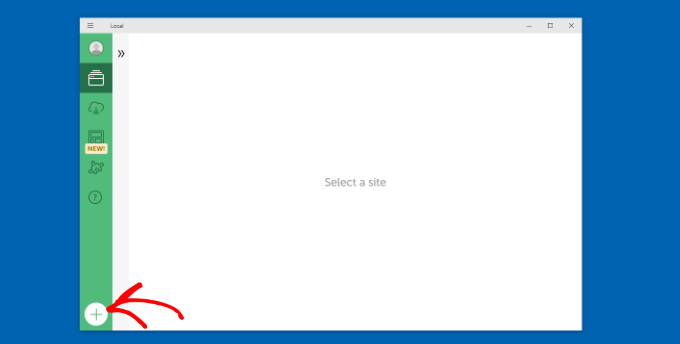
Depois disso, você pode criar um site no software Local.
Selecione a opção “Create a New Site” (Criar um novo site) e clique no botão “Continue” (Continuar).
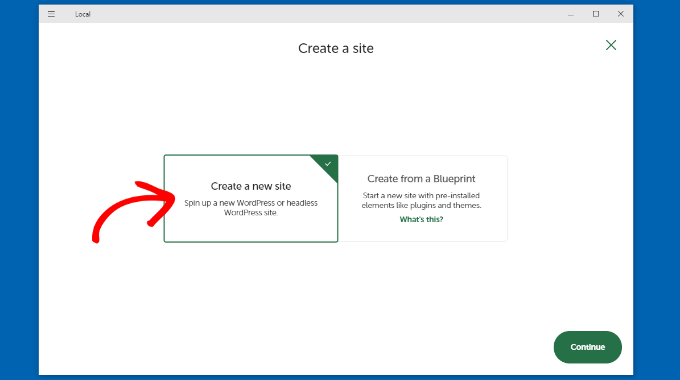
Em seguida, você pode inserir um nome para seu site local, como wordpresslocalsite.
Há também opções avançadas em que você pode inserir o domínio do site local e o caminho do site local. Se estiver apenas começando, recomendamos manter as configurações padrão.
Quando terminar, basta clicar no botão “Continue” (Continuar).
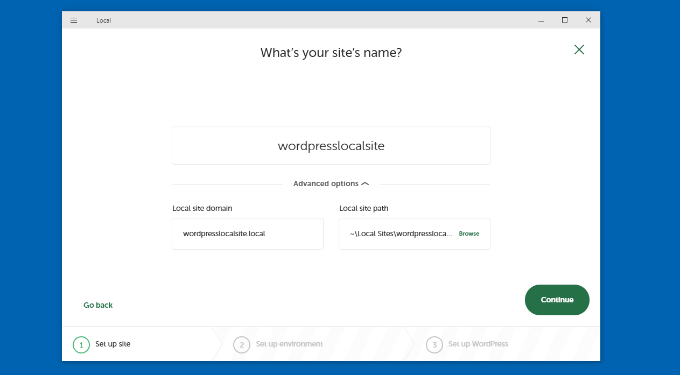
Depois disso, você precisará escolher um ambiente para seu site local.
Você pode usar o ambiente “Preferred”, no qual o software selecionará automaticamente a versão do PHP, o servidor da Web e a versão do MySQL. Por outro lado, você também pode selecionar “Custom” (Personalizado) e inserir os detalhes do ambiente.
Para este tutorial, usaremos as configurações preferenciais e clicaremos no botão “Continue”.
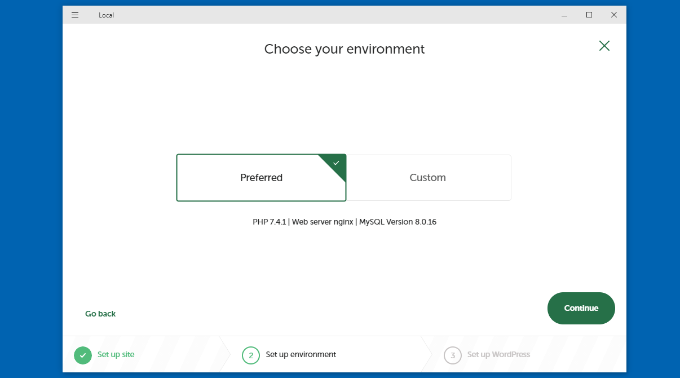
Em seguida, você pode inserir um nome de usuário e uma senha do WordPress para o seu site local. Além disso, há também uma opção para escolher um endereço de e-mail do WordPress no qual você receberá todas as notificações por e-mail.
Há também uma opção avançada em que o software perguntará se você tem uma rede WordPress multisite.
Depois de inserir esses detalhes, basta clicar no botão “Add Site”.
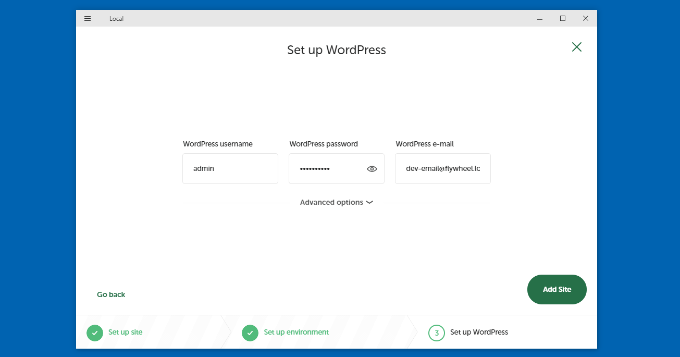
O software agora instalará o WordPress e configurará seu site.
Para iniciar o site local, clique no botão “WP Admin” no software.
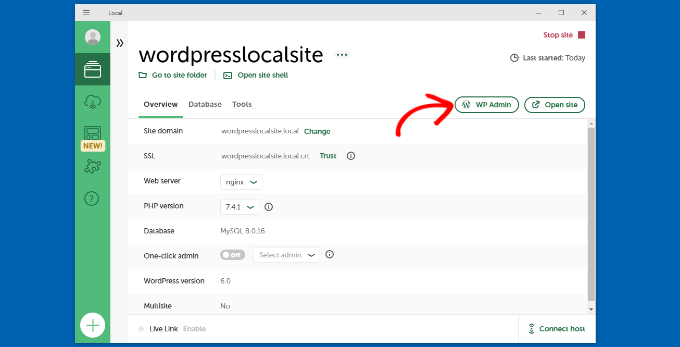
Em seguida, você verá a página de login do administrador do WordPress.
Basta digitar o nome de usuário e a senha que você inseriu anteriormente ao configurar o site local e, em seguida, clicar no botão “Log In”.
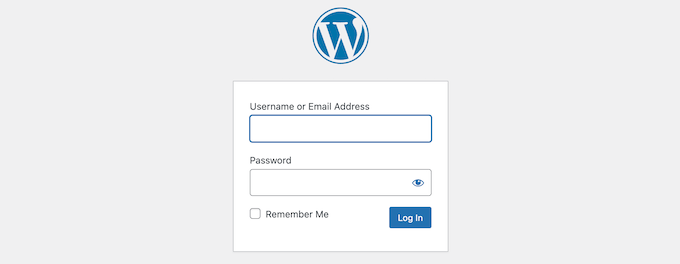
Agora você pode editar o site local em seu computador Windows.
Quando terminar, não se esqueça de interromper o site do software Local WP clicando no botão “Stop site”.
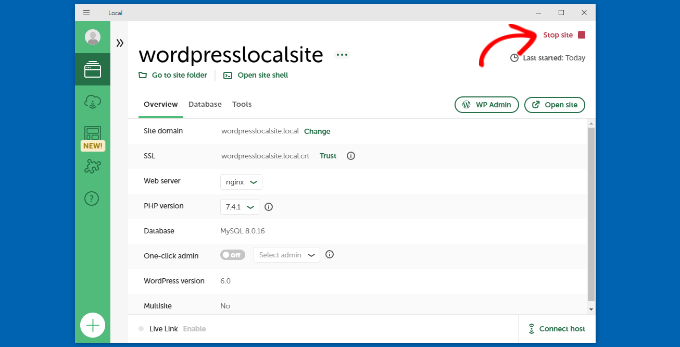
Instalar o WordPress no Windows usando o WampServer
O WampServer ou WAMP é uma compilação do servidor da Web Apache, PHP e MySQL para computadores Windows.
Todos eles são softwares de código aberto separados. No entanto, instalá-los separadamente não é muito fácil, mesmo para usuários experientes. Softwares como o WampServer permitem que você os instale facilmente e tenha um ambiente local funcional em poucos minutos.
Primeiro, você precisa fazer o download do software WAMP e instalá-lo em seu computador. Basta acessar o site do WampServer e clicar no botão “Start Using WampServer”.
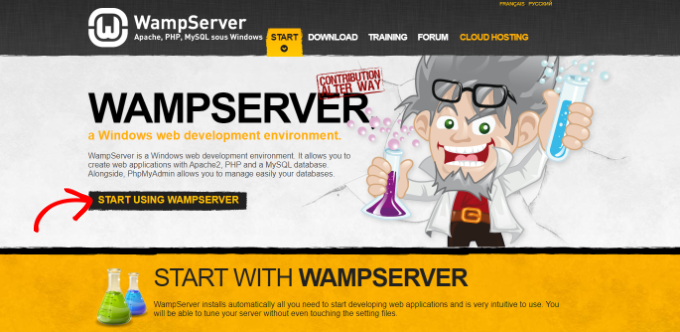
Isso o levará à seção de downloads. Você verá duas versões aqui: WampServer 32 bits e WampServer 64 bits.
É necessário selecionar a versão do WampServer que corresponda ao tipo de sistema operacional do seu computador Windows.
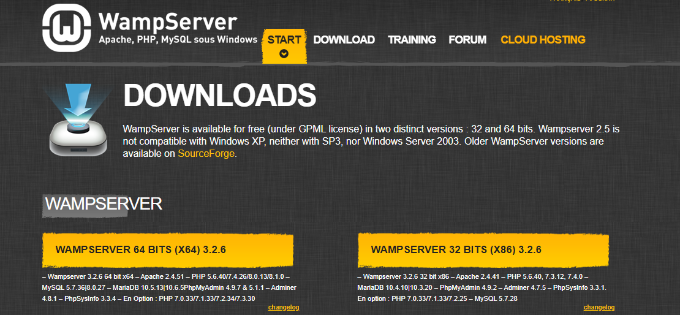
Para saber se você está usando um sistema operacional de 32 ou 64 bits, basta procurar por “Painel de Controle” na barra de pesquisa da barra de tarefas Iniciar.
Depois disso, você pode ir para System and Security ” System em seu computador. Lá você poderá ver o tipo de sistema.
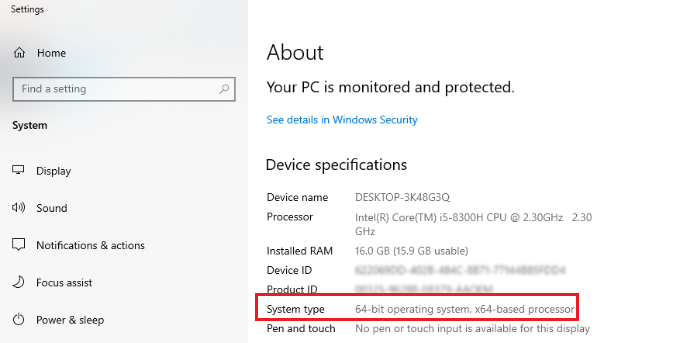
Agora que você conhece o tipo de sistema operacional Windows, basta selecionar a versão correta do software WampServer.
Quando você clicar no botão de download, será aberto um formulário solicitando seus dados pessoais. Se você não quiser fornecer essas informações, clique no link “você pode fazer o download diretamente”.
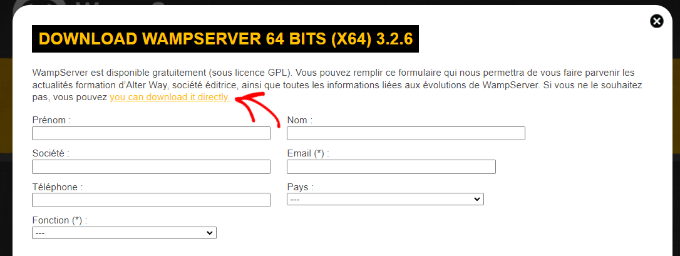
Após o download, você pode clicar no arquivo de execução do WampServer para executar a instalação.
Agora, selecione um idioma no menu suspenso e clique no botão “OK”.
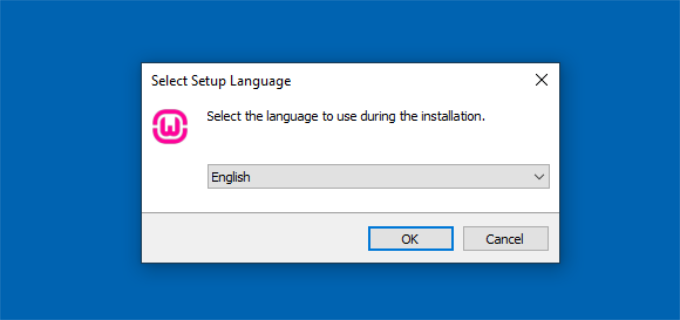
Na próxima etapa, você verá o Contrato de Licença.
Selecione a opção “I accept the agreement” (Eu aceito o contrato) e clique no botão “Next” (Avançar).
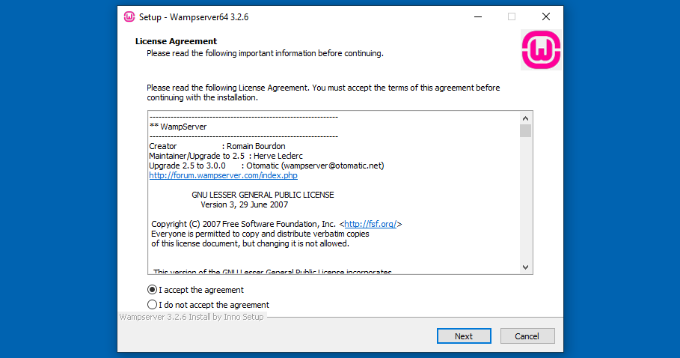
Depois disso, o assistente de configuração mostrará informações sobre a instalação do WampServer.
Você pode simplesmente clicar no botão “Next” (Avançar) para continuar.
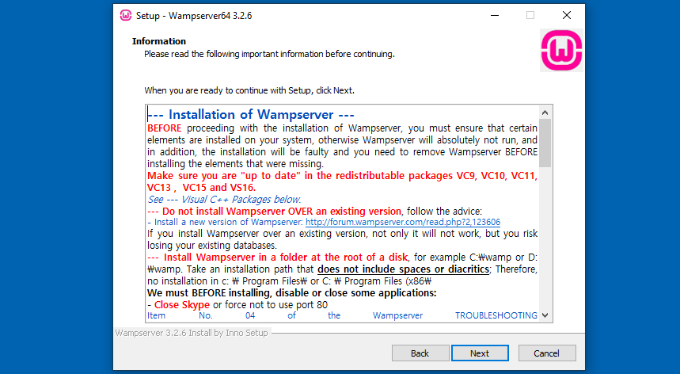
Em seguida, você pode selecionar o local de destino onde o software será instalado.
Para alterar o local padrão, clique no botão “Browse” e escolha a pasta de sua preferência. Quando terminar, clique no botão “Next” (Avançar).
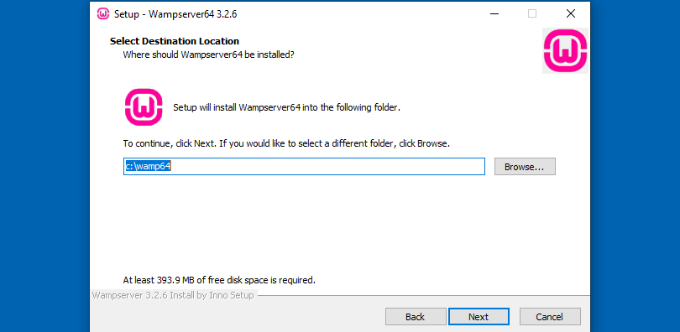
O assistente de configuração solicitará que você selecione diferentes componentes que deseja instalar. Eles incluem as versões do PHP, do MySQL e outras.
Você também pode manter as opções padrão e clicar no botão “Next” para avançar.
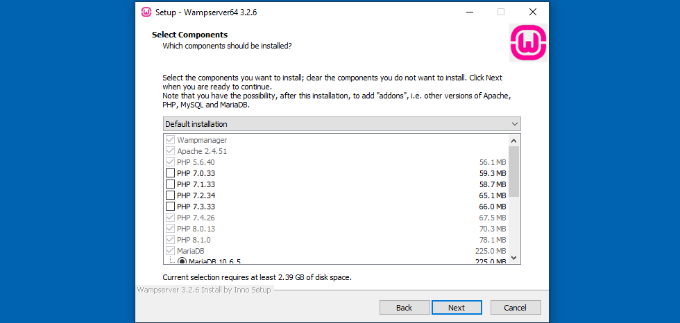
Em seguida, você pode selecionar uma pasta do menu Iniciar. Clique no botão “Browse” para escolher uma pasta diferente.
Depois de selecionar uma pasta, clique no botão “Next” (Avançar) para continuar.
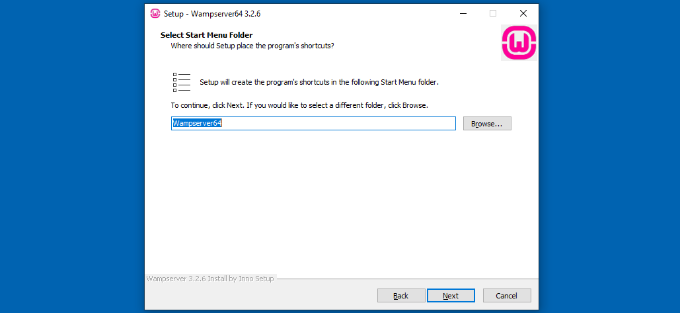
O software estará pronto para ser instalado. Você pode ver um resumo do local de destino, do tipo de instalação, dos componentes selecionados e muito mais.
Clique no botão “Install” (Instalar).
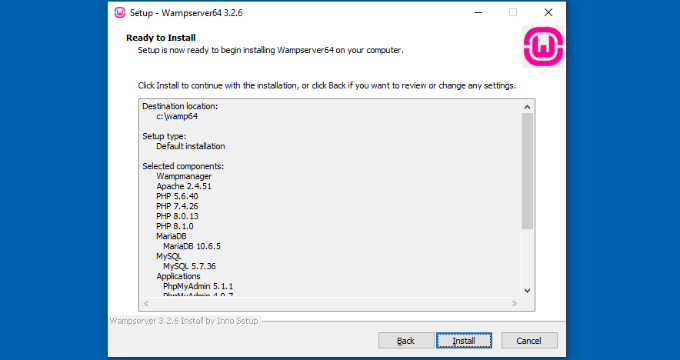
Durante o processo de instalação, você precisa definir o local do navegador da Web. Por padrão, ele será o Internet Explorer.
Você pode alterá-lo para o Google Chrome ou qualquer outro navegador da Web, localizando-o nos Arquivos de Programas do seu computador.
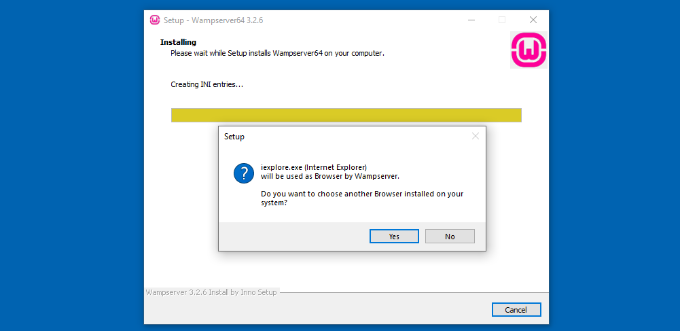
Da mesma forma, ele também perguntará se você deseja usar o Notepad ao usar o WampServer.
Depois disso, o assistente de configuração mostrará informações sobre como o WampServer funciona.
Continue e clique no botão “Next” (Avançar).
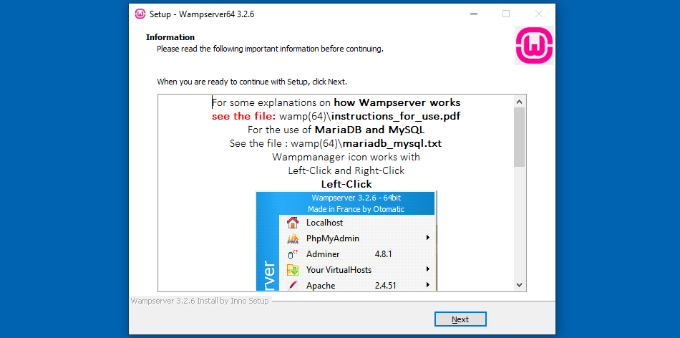
Agora você instalou com êxito o WampServer em seu dispositivo Windows.
Basta clicar no botão “Finish” (Concluir) para sair do assistente de configuração.
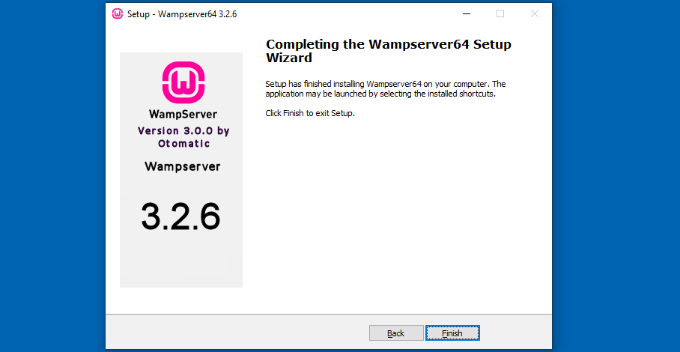
Depois de instalado, você pode iniciar o WampServer a partir do atalho da área de trabalho ou do local de destino onde o software foi instalado.
A próxima coisa que você precisa fazer é criar um banco de dados MySQL em branco.
Ao iniciar o WampServer, você verá um ícone verde no canto inferior direito da tela, junto com outros ícones. Basta clicar com o botão esquerdo do mouse sobre ele e, em seguida, clicar em phpMyAdmin (um aplicativo baseado na Web para gerenciar bancos de dados MySQL).
Observação: Se o ícone do WampServer estiver vermelho ou amarelo, isso significa que os serviços (Apache, MySQL, PHP) não estão em execução. Você precisa iniciar os serviços clicando no ícone antes de configurar o banco de dados.
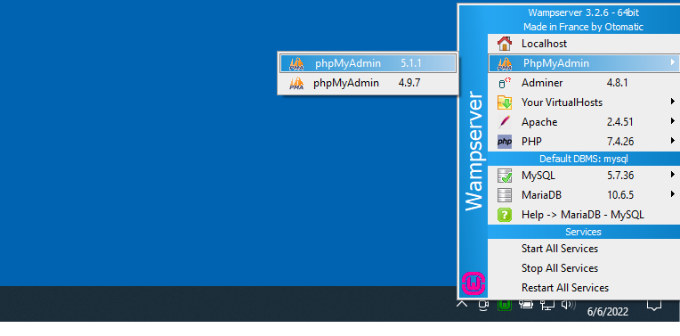
Isso o levará à tela de login do phpMyAdmin no navegador da Web.
Basta digitar o nome de usuário: root e deixar o campo da senha em branco. Essas são as credenciais padrão para fazer login no phpMyAdmin do host local.
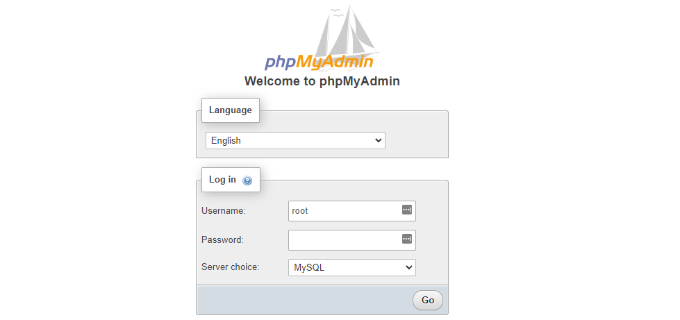
Clique no botão “Go” (Ir) para continuar.
Uma vez conectado, você precisa clicar em Databases (Bancos de dados) no phpmMyAdmin para criar um novo banco de dados para o WordPress.
Ele solicitará que você escolha um nome para o seu novo banco de dados (chamamos o nosso de test_db). Depois disso, clique no botão “Create”.
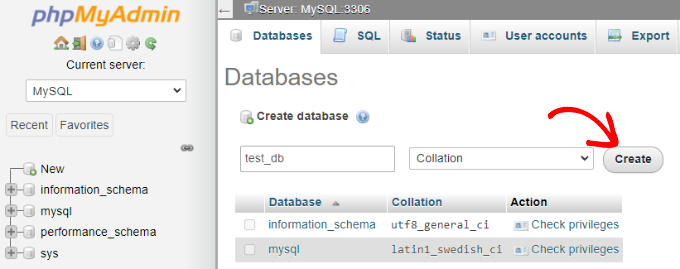
Seu banco de dados está pronto, o que significa que agora você pode instalar o WordPress no localhost.
A próxima coisa que você precisa fazer é baixar a versão mais recente do WordPress no site WordPress.org. Ele será baixado como um arquivo zip.
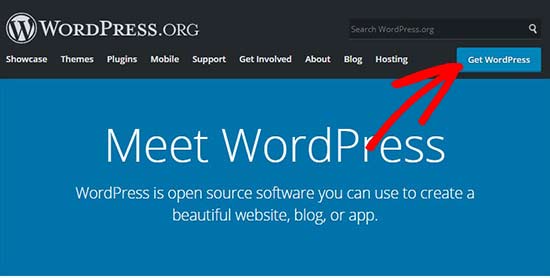
Em seguida, você precisa extrair o arquivo zip e copiar a pasta “wordpress”.
Para este tutorial, estamos usando o WinRAR para descompactar o arquivo. Basta clicar na opção “Extract To” (Extrair para) na parte superior.
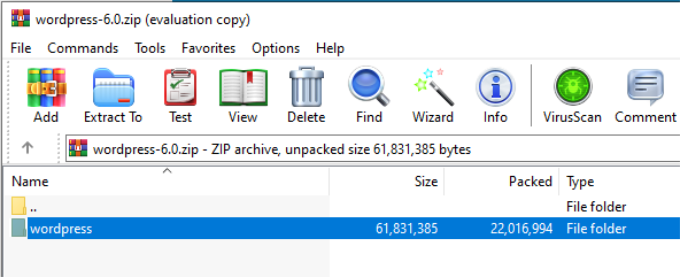
Agora você precisa navegar até a pasta em que instalou o WAMP.
Neste tutorial, instalamos o WAMP em C:\wamp64, portanto, faremos referência a essa pasta daqui para frente. No entanto, lembre-se de que ela pode ser diferente para você, dependendo de onde instalou o programa.
Cole a pasta “wordpress” na pasta C:\wamp64\www.
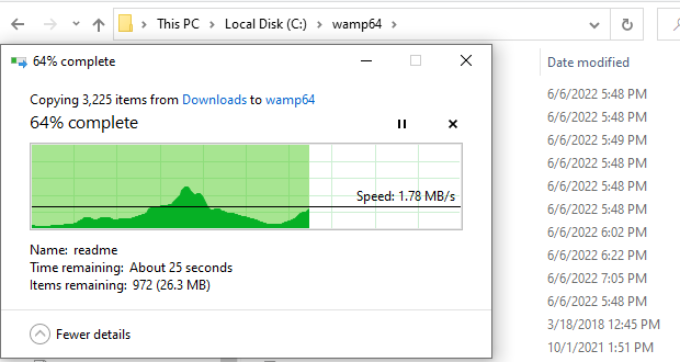
Você pode renomear a pasta ‘wordpress’ para qualquer nome que desejar, como mysite, testsite, etc. Esse será o URL do seu site local do WordPress, portanto, escolha algo que seja fácil de lembrar.
Para fins deste tutorial, renomeamos a pasta de wordpress para mysite.
Em seguida, você pode abrir o navegador da Web, acessar http://localhost/mysite/ e clicar na pasta “wordpress”.
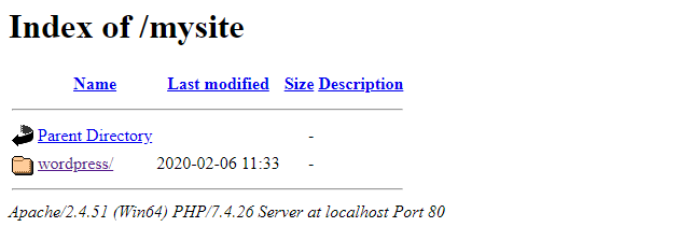
Primeiro, ele solicitará que você selecione um idioma e, em seguida, mostrará as informações de configuração do banco de dados.
Depois de selecionar um idioma, clique no botão “Continuar”.
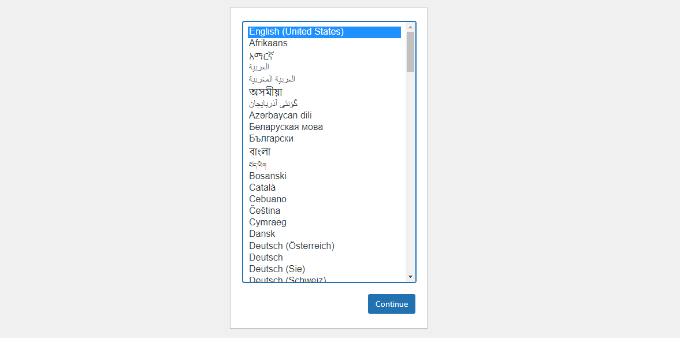
Em seguida, você verá um aviso de boas-vindas ao WordPress.
Depois de lê-lo com atenção, clique no botão “Let’s go” para continuar.
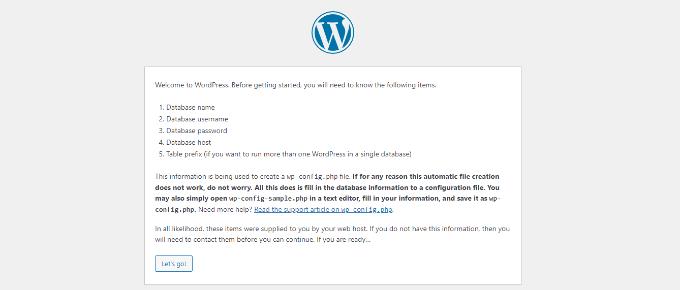
Depois disso, é necessário inserir os detalhes do banco de dados, como nome do banco de dados, nome de usuário, senha, host e prefixo da tabela.
O nome do banco de dados será aquele que você inseriu na etapa anterior. No nosso caso, nós o chamamos de “test_db”. O nome de usuário será “root” e você pode deixar o campo de senha em branco. Você também pode deixar o host do banco de dados e o prefixo da tabela como estão.
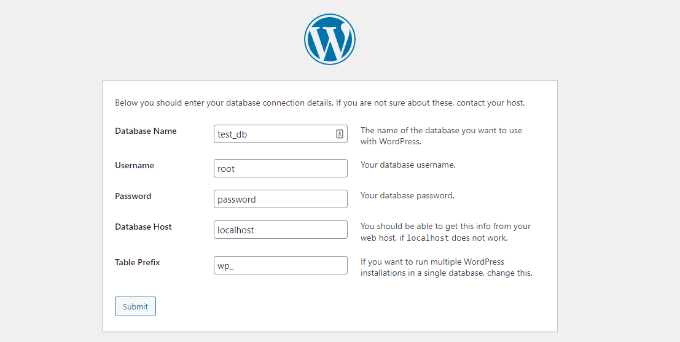
Em seguida, clique no botão “Submit” (Enviar) e o WordPress criará um arquivo de configuração para você no backend.
Na próxima tela, você verá uma mensagem de sucesso informando que o WordPress está conectado ao seu banco de dados e que você pode prosseguir com a instalação.
Clique no botão “Executar a instalação” para continuar.
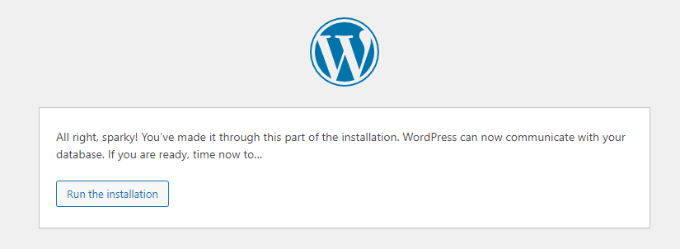
Isso o levará à tela de boas-vindas do WordPress. Você precisa adicionar um título ao seu novo site do WordPress, escolher um nome de usuário de administrador, digitar uma senha forte e fornecer um endereço de e-mail de administrador.
Quando estiver pronto, clique no botão “Install WordPress” (Instalar WordPress).
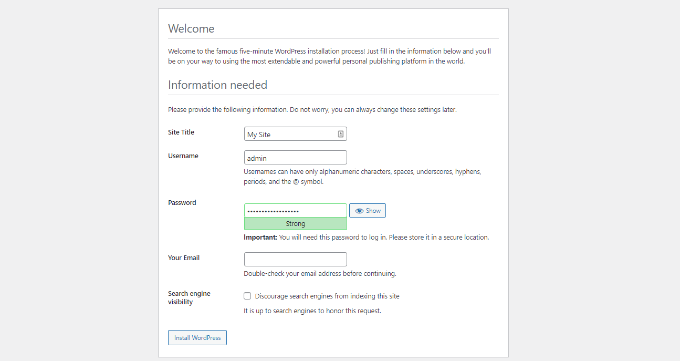
Após a conclusão do processo de instalação, você verá uma mensagem de sucesso. Em segundo plano, o WordPress criou novas tabelas em seu banco de dados e está pronto para ser usado.
Em seguida, você pode acessar o painel do WordPress clicando no botão “Log In”.
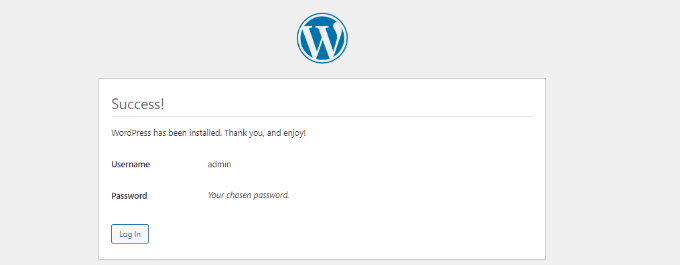
Parabéns, você instalou com sucesso o WordPress em um computador Windows usando o WampServer.
Basta fazer login no painel de administração do WordPress e começar a editar seu site em um ambiente local.
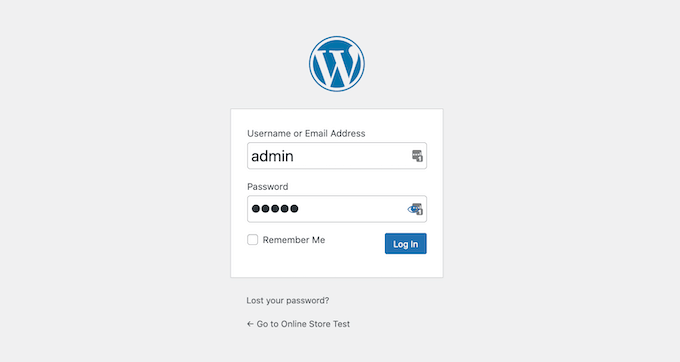
Ativação de Permalinks bonitos no WAMP
A nova versão do WordPress não quebra seu site local ao alterar a configuração de permalinks.
No entanto, se você ainda vir o erro “página não encontrada” em suas páginas depois de alterar os permalinks em Configurações ” Permalinks no WordPress, basta seguir nosso guia sobre como ativar permalinks personalizados no WAMP.
Bônus: Migrando o WordPress de local para ao vivo
Também escrevemos um guia separado sobre como mover o WordPress do servidor local para um site ativo. Esperamos que ele seja útil quando você estiver pronto para implantar seu site local na produção.
Ter um ambiente de servidor local é ótimo para fins de aprendizado e teste. No entanto, se você quiser iniciar um blog do WordPress para que outras pessoas o vejam, não precisará instalar o WordPress no seu computador. Você precisa instalar o WordPress em um provedor de hospedagem WordPress.
Esperamos que este artigo o tenha ajudado a aprender como instalar o WordPress em um computador Windows. Talvez você também queira ver nosso guia sobre SEO para WordPress e como iniciar uma loja on-line.
Se você gostou deste artigo, inscreva-se em nosso canal do YouTube para receber tutoriais em vídeo sobre o WordPress. Você também pode nos encontrar no Twitter e no Facebook.





Syed Balkhi says
Hey WPBeginner readers,
Did you know you can win exciting prizes by commenting on WPBeginner?
Every month, our top blog commenters will win HUGE rewards, including premium WordPress plugin licenses and cash prizes.
You can get more details about the contest from here.
Start sharing your thoughts below to stand a chance to win!
Bidyut Kumar Mondal says
Thanks a lot for such a wonderful post.
Ali says
Just to say Thank you very much.
sreenu says
thank you…thank you soooooooooooo much ..
Nissim says
Thank you so much. this was sterling
adriana says
OMG i made it through. lol. thank you for your time writing this, it helped me through the panic stage lol
mahendra says
Who help of peoples, They are God
Kenneth Ekeh says
Help please! I have followed the article and installed wamp, created the wp database but culd not be able to run complete configuration of wp. Its telling me “can’t select database”. Try Again. Please help me to fix this. Thanks.
WPBeginner Support says
During the installation when it asks for your database details, please make sure that you are entering the same name for the database which you used when creating database in phpmyadmin. For username, use root and leave password blank.
Administrador
Tom says
Upon opening mysql workbench, choose your connection, then write the code without quotes “create database nameofyourdatabase;” this will be the name of your database and what you will use in the wordpress setup when it asks for the name of your 1)database(use nameofyourdatabase) 2)username 3)password 4)database host(im using “localhost”)
Hope this helps.
Tammi L. Coles says
Just a quick note of thanks for this very simple-to-follow tutorial. It worked like a charm (including the Apache rewrite for permalinks follow-up).
ogunmakinwa dayohanks. says
Your tutorials as been good for me so far, but please which stable wordpress can i download? can i download the latest version? i am just thinking that some plugins might not be available for the latest version.. so for now which version do you recommend for me? thanks
WPBeginner Support says
We always recommend using the latest stable version of WordPress.
Administrador
Mohamed Ishag says
Hi there,
Would you please answer the question posted on 12/11/13 I still need help
as I am unable to run the WAMP Server on Windos 8. Please read question posted on 12/11/13.
Thank you in advance.
Regards,
Mohamed
Orestes says
I was able to install WP, but I’d like to know how to manage different web logs within my local server. Thank you for the instructions and tutorials here.
WPBeginner Support says
you can install different weblogs (blogs or websites) on the same server by installing wordpress in different sub-directories inside your
/wamp/wwwfolder. For example:C:\wamp\www\site-1 will open in http://localhost/site-1
C:\wamp\www\site-2 will open in http://localhost/site-2
Administrador
GinoDC says
After entering details for Site Title, Username, Password and Email I press Install WordPress and my computer hangs. Please help.
WPBeginner Support says
This could happen for a number of reasons. Try to uninstall wampserver and then download and reinstall again. If the problem presists, then you can try XAMPP.
Administrador
Mohamed Ishag says
Hello,
I have installed WAMP on Windows 8 but I am having a problem creating a data base due to the following error (You don’t have permission to access /phpmyadmin/ on this server). I have edited the htpd.conf file as follows
Open file httpd.conf through wamp tray icon
Find:
# onlineoffline tag – don’t remove
Order Deny,Allow
Deny from all
Allow from 127.0.0.1
Change to:
# onlineoffline tag – don’t remove
Order Deny,Allow
Allow from all
Then saved but still get the same error, why!? Norton 360 is installed on the PC
and no other conflicting apps. I need some help to fix this issue. Any ideas? Thank you in advance.
Best Regards,
Mohamed
Mohamed Ishag says
Dear Syed and the team,
Thank you very much for this site. I am new to WordPress and found your tutorials and explanation very good and straight forward. I feel that you are a busy man but still have time to dedicate this site to new WP beginners. God bless your parents.
Salam,
Mohamed
adam says
Hello,
I have installed everything and am finally at my wordpress dashboard on my localhost machine. everytime i click on visit my site to view what I have changed the page simple directs to the WAMP server configuration screen that shows apache version, php version, loaded extensions, etc… It seems that something simple needs to be changed but I dont know…Can anyone please help? Thanks in advance…
WPBeginner Support says
You have probably installed WordPress in www directory. You need to install it in a subdirectory like www/testsite1/
Administrador
Nuno says
Hey i have the same problem, so if i just copy all the files to a subdirectory it will work or do i have to reinstall it all over? Thanks.
Matthew says
Thank you, than you, thank you. I am a technophobe and your clear instructions helped me all the way.
Arthur says
Hi,
After installing WAMP in accordance with your instructions, I could not open phpmyadmin; explorer kept waiting for localhost. I’m not a pc techie so I desperately need instructions how to proceed furter in the same easy way as your manual above. I have a 64 bit W7 machine, and installed the 64 bit version of WAMP first, but since that did not work as described , I installed the 32 bit, but with the same result. Thanks for your help in advance ! (No Skype, port 80 OK, as far as I can see)
WPBeginner Support says
Try restarting all services make sure that WAMPServer icon is green also make sure that Skype is not running in the background. Also look at this support thread for more possible solutions.
Administrador
Arthur says
Thanks a lot: I followed your recommended thread and I removed a double line in the Host file (‘127.0.0.1 Localhost’) that seemed too much and now I can get to a log-in page of phpMyAdmin, which is great, but I have not yet even entered an ID and password during initial installation of WAMP. Did I miss something ?
Thanks for your patience again…
WPBeginner Support says
To log in to phpMyAdmin, enter username root and leave password blank.
Trudy Ritsema says
Can I run more than 1 test site on WAMP? and any ideas of how I would go about this please?
I already I have localhost site running – and I don’t want to get rid of that yet as I am still developing it…
Thanks in advance.
WPBeginner Support says
in your www directory create new directories for each website. That way you can run multiple sites on localhost.
Administrador
viki says
i can’t create new database, bcause it is showing ” * No Privileges” in red colour letters. please help me
WPBeginner Support says
you are probably entering wrong credentials to connect to your mysql database.
Administrador
nick mav says
you should login using the following credentials:
username: root
password: [empty] –> that is, no password
Shawn Morrissey says
Thanks Nick,
I had the same issue and couldn’t find this out anywhere I had looked previously…
SanketP says
Hi. I am a new-bee to this world of eb designing. Wanted Joomla but that didnot go thru too well. WP instal was as good for me. Thank you. XOXOXO.
Everett says
Hello. I want to be able to develop my wordpress site locally and not have to be connected to the web when I make changes and do save or update inside wordpress. Before I go through all the installation of WAMP and WP locally, can anyone tell me if I will have to have internet access to make updates to a wordpress running locally in WAMP? Sure I realize if I wanted a new Theme or Plugin, I would have to be online, but if I am just making adjustments to text and adding pictures that are already on my laptop, etc. will I have to have internet access to do so? I ask because I do a lot of travel where I am on an airplane and could be working on a new version of a website if I don’t have to be online. Also, I can’t afford a wireless account for my laptop, so I only have internet when I am at home with my own wifi or when I am somewhere that has a free wifi. Thanks.
WPBeginner Support says
no you do not need an internet connection to work locally on your website.
Administrador
Ian says
I followed the instructions to the letter, installed WAMP and the required SP1 Visual C++ on a brand new laptop running Windows 8 64bit. The installation refuses to launch, brings up a screen asking if I’m sure I want to let this programme make changes to the computer, then does nothing when ‘Yes’ is clicked. What is going wrong?
WPBeginner Support says
Does the wampserver icon appear in your windows taskbar? If it does, then you need to click it and launch wampserver.
Administrador
Brynn says
Please help. I installed WAMP but when I went to open phphMyAdmin, nothing happens. I tried uninstalling and reinstalling, but still getting the same problem. I’m not even getting any sort of popup block notification in my browser. Just nothing.
I wonder if this might have something to do with the WARNING window that popped up on the WAMP website before I downloaded it… It said something in French, and then something about needing to install C++ which I know nothing about, and which was not mentioned in this tutorial.
Do I need to install C++ and if so, do I need to learn how to use the programming language before I can finish this tutorial on installing WordPress? I am a designer, not a programmer, so I hope to god I don’t need to stop everything and go learn C++ before I can do a simple WordPress install.
WPBeginner Support says
Brynn you can always check whether or not Microsoft Visual C++ is installed on your computer from Control Panel -> Programs and Features. Do you see wampserver page when you visit http://localhost? If you do, then you have already successfully installed WAMP.
John Victor says
Can I hug you now or later?
Anudeep says
Awesome tutorial
guru says
I install wordpress to my localhost. But i dont know to use it to develop a site. I’m new to wordpress. Please anyone help me.
WPBeginner Support says
Take a look at our beginner’s guide section. For theme development you may want to take a look at our WordPress theme cheat sheet for beginners.
Administrador
Scott Cho says
Got WAMP installed, but when I try to create a new databse by clicking on the phpMyAdmin button in WAMP the chrome browser window that opens up says:
Forbidden
You don’t have permission to access /phpmyadmin/ on this server.
Can anyone point me in the right direction as to what this is and how to fix it? I don’t know if this makes a difference but I have it installed on my secondary hard drive, not my C drive (the c drive just has my operating system).
Asad Riaz says
Here is how you edit the htpd.conf file
Open file httpd.conf through wamp tray icon
Find:
# onlineoffline tag – don’t remove
Order Deny,Allow
Deny from all
Allow from 127.0.0.1
Change to:
# onlineoffline tag – don’t remove
Order Deny,Allow
Allow from all
Plus resolution to some other conflicts
Make sure no other program conflict wamp such as Xampp, phpEasy, IIS, Skype, Zonealarm, firewall/antivirus, NOD32, Eset, any web and/or Remote Desktop related program, such as Teamviewer …
IIS and Apache/Wamp are both web server and might conflict in some way, so you have to disable IIS in order for Wamp to work
Disable IIS in Vista/W7:
Control Panel, Uninstall Programs, Turn Widows Features On or Off, uncheck Internet Information Services
Disable IIS in XP:
Control Panel, Add/Remove Programs, Add/Remove Windows Components, uncheck Internet Information Services (IIS)
Restart computer, then restart Wamp
Also, in folder C:\WINDOWS\System32\drivers\etc, open file hosts and delete anything in this file and have only this line below and nothing else
127.0.0.1 localhost
If using Skype, go to Tools->Options->Advanced->Connection and uncheck the box “Use 80 and 443 as alternatives for incoming connections”. Restart Skype after WAMP. Now you will be able to use both programs at the same time w/o problems.
I hope it helps, found it on net
Asad Riaz says
Howdy,
Well i have managed to install it using the article. Some info was missing in this article like
1. Once you click on phpMyAdmin, it asks for login details, so here they are:
username: root
pass: (leave it blank)
2. WAMP sometimes gets offline and it wont open the phpMyAdmin page, so you guys need to edit the htpd.conf file in C:wamp/bin/apache4.2/conf/htpd
Lets see now how much it helps me.
I m here for all the support that i can extend.
Thanks to the author of this page.
Cesar M. says
thanks for the user info I was getting crazy, but I finally got in to phpmyadmin
Colin Teasdale says
Hiya,
Problem solved – I had needed to install the Visual C# redistributable, and did that after installing Winamp. Uninstalled Winamp, rebooted and then re-installed – everything fine. That’ll be user error then ! ! !
Colin T.
Scott Cho says
I’m getting the same error you just described below, where is this redistributable you speak of?
Colin Teasdale says
Hi guys,
I’ve just downloaded and installed WAMP and have got to the “set up a database” stage. When I select ‘phpMyAdmin’ I get a ‘Firefox Problem Loading Page’ page with “Unable to connect – Firefox can’t establish a connection to the server at localhost”.
I’ve tried the fix suggested by Imran on June 17th, but this doesn’t seem to have fixed resolved the problem.
Any thoughts on how I fix this, please??
Peter says
Hi Editorial Staff,
Do you have a tutorial that is the reverse process also using WAMP? I have a functioning website that I would like to duplicate on my home computer for experimenting and learning css, and php programming without risking my functional website.
Thanks.
EL says
That is exactly what I need!
Denzil says
Hi, a very useful article, thanks. Is it easy to migrate a test WP site on WAMP to a hosted site elsewhere? Do you have a tutorial article to help?
Thanks
Editorial Staff says
Yes, it is fairly easy to do that. Tutorial will be coming tomorrow
Administrador
Denzil says
Great! How timely! Thanks guys, looking forward to it.
Kate BP says
Absolutely cracking article – really helpful, thanks so much!
akash says
After clicking on phpmyadmin,,,,,,,
i am getting redirected to directly php my admin webpage and not the database entry option which is shown above.
thereafter the details are not matching afterwards in database,username and password.please give me its solution as soon as psbl.
Amitoj Gautam says
User Name: Root
Password: None (Leave this space empty)
Click on the Go button. You will be directed to the page you are looking for.
Dana says
Hi! Once I’ve created a site on my WAMP server, could I then transfer it to an existing domain name? I’m trying to create a new site without shutting down the old one. Once the new one is finished, I would want to replace the old one, but use the same domain name. Thank you!
Editorial Staff says
Yes you can do that. We have updated the article to add a link to the tutorial.
Administrador
vahid says
Thank you so much
chris martin says
Hi, I am having trouble with links not working. Could you help me or give me some direction on how to fix that? On my site “chrisjamesmedia.com” click menu, then “blog” and i get “not found”. This also happens with links as well.
Also, do you have a tutorial on how to host multiple domains from this as well, or point me in the right direction.? I have looked up several things about virtual domain, localhost, and everytime I find something they want me to edit httpd conf, but what they have doesnt match mine.
Thank you so much!!!!
Tamsin says
Hi,
Great article, very clearly explained.
Would you be able to tell me the best way to add a second WordPress site to Wamp? I have read a lot of conflicting information and would rather not make a massive mess of things!
Editorial Staff says
Create a new folder inside your www folder, then repeat this process.
Administrador
Tom Smith says
Hi,
Thank you for providing this excellent tutorial! It’s going to be great to get use to using WP onn my PC before I install it on my host server and create my website.
I followed your instructions and installed WAMP and then WordPress and got all the screens you showed here… and with the tweaking you suggested, I was finally able to open WP – saw the Dashboard, etc. Then I closed it.
But now I can’t seem to open WP. I open WAMP and click on Localhost – and it just sits “waiting for response from localhost” – does not open anything. I’ve tried http://localhost/my database name – it will not open – I get “HTTP 500 Internal Server Error”. Just in case, I also followed your instructions on SKYPE and unchecked that Port 80 box.
What am I missing?
Editorial Staff says
Did you shut down your computer? You have to launch WAMP Server every time you restart your computer.
Administrador
Imran says
When i try to Setting Up a Database for WordPress, it was saying like this : Forbidden
You don’t have permission to access /phpmyadmin/ on this server. what is the reason ? can you please guide me. thank you in advance….
Editorial Staff says
That’s weird. Since you are the admin of your Wamp install, then you shouldn’t get this error.
Administrador
Imran says
Finally i got the solution…
I think it will be useful for others.
for phpmyadmin
Goto c : wamp/alias/phpmyadmin.conf file, open with notepad.
find
Options Indexes FollowSymLinks MultiViews
AllowOverride all
Order Deny,Allow
Deny from all
Allow from 127.0.0.1
replace with
Options Indexes FollowSymLinks MultiViews
AllowOverride all
Order Deny,Allow
Allow from all
thats it…
Imran says
Thank you very much EDITORIAL STAFF, this is a nice post and very usefull.
Melanie says
I had this same problem with the phpmyadmin and I found and made the changes cited here to the alias file, then restarted WAMP and I was able to create my database. However, now I’m getting the same Forbidden message when I try to install WordPress on my localhost, exact text below:
Forbidden
You don’t have permission to access / on this server.
I can get to the WP install screen from 127.0.0.1, but not localhost. I’m running Windows 8. Any ideas on how to get this to install? Thanks in advance for any help you might be able to give me.
Akshay says
Hi.
I wanted to use this method to test out plugins before installing then on my live site. So in your tutorial, instead of copying in clean WordPress files, I copied in a full backup of my site made using BackupBuddy.
However from this point on I’m not sure what to modify in order for my site to function correctly offline. I edited my wp-config file to the new database details, and imported my database from my online phpmyadmin to the WAMP one. However it seems like there’s something I’m missing, as when I try to access localhost/site/wp-admin I am redirected to my online login page.
Do you have any suggestions?
Thanks very much for your help.
Akshay
Brandi says
I’m in the same boat – did you ever find a solutions?
Christophe R. says
Another (lazy) point for XAMPP : I know there are some differences in the config files, but I use both linux (at home) and Windows (Seven and 8) at work, so I appreciate having the same interface for I only have to learn once.
Andre says
Great article and easy instructions for those who want to venture into WAMPP….however, for myself, I still prefer XAMPP and do run it on it’s own on a second drive without the installable version. Updating is a breeze, although I rarely need to.
I’ve used XAMPP for many years now for both WordPress and Joomla theme development, as well for a testing server. Never had issues and I do find it quite easy to use. I used to use the full version but I found that the Lite version works extremely well.
I noticed someone said AMPPS, but I’ve never tried that…perhaps in my spare time I will try it out.
Nicholas says
Its click and install that’s how easy it is and just open to localhost/ampps i use it for all my scripts that this includes as downloads and install on the service. no worries on xamp and wamp that i found to limited in some ways.
Adrian says
Thanks alot it was really helpful
Thomas says
Hi everyone,
I’m a very beginner with WordPress and I have created a site with it and WAMP on my computer.
Now I want to put it online, but I don’t know how to do it.
Where does a tutorial exist for that?
The thing is that I want to replace the current site, which is hosted somewhere else, and so keeping the domain name.
Does anyone know where I can find this kind of information?
Thanks a lot!
Nicholas says
WAMP in the older days was great! Now there is a far more better and less embarrassing way when it comes to configuring things with WAMP. WAMP is in the past and gone for me. I use AMPPS far more better no configurations, just install and a few dips of changes in the options section that’s it. Open your browser go to your localhost and install any cms or other scripting lang within your browser using ampps. You’ll be amazed! No more downloading then extracting in www folder and then reconfiguring. WordPress is just a click and install on ampps. No hassle! Shouldn’t you guys write something about AMPPS? This is a lot more better than WAMP! WAMP lags a lot of things like cgi and stuff those are extras, but on ampps everything is included. Ever since ampps I never looked back to wamp! Sorry!
Editorial Staff says
Have been using WAMP for so long that didn’t even bother with another option. AMPPS sure looks good. Good to see that it is made by the folks from Softaculous. Will have to give it a try.
Thanks for the suggestion Nicholas.
Administrador
Zimbrul says
Why do you say you prefer WAMP over XAMPP?
Alexander Gounder says
WAMP is much simpler and easier to use compared to XAMPP.
Editorial Staff says
Would second that. WAMP is easier to use. Several years ago when we used XAMPP the upgrade process was complicated and it was buggy. We switched over to WAMP and it was awesome.
Administrador
Parth S. says
Hi, Thank you very much for this. It’s very informative and easy to follow. However I’d suggest you mention the skype thing a lil early around the localhost point, because, there ppl start to worry when they see a blank screen with skype on in their PC.
Great post though. Keep it up.
Mladen says
Just to mention, that Team Viewer also causes problems with WAMP.
Christophe R. says
I actually do prefer XAMPP and DTX-Control for I can overcome security policy : Installation without administration rights (zip file pour the web server) and full access to blocked ports (80, 443, 3306).